Industrial Chandelier
Happy new year everybody! Welcome back to my first post in 2019. I’ve got a lot of fun projects coming up. I spent as much time as I could over the holidays working on new projects to bring to you.
Also, I’ve been focusing a lot on my Instagram pages lately. So if you want more frequent ZacBuilds posts that’s the place to look. So if you like this post and my blog, please check me out there!
Let’s talk about this project though. Have you ever tried to pick out a new light fixture? It’s hard right?! I tried for a long time to find something that worked for me but I just couldn’t find anything that really made my heart sing, you know, as a light fixture should. It was all just a sea of cheap plastic painted to look like brushed metal with LED bulbs leaned way too far to the “cool” side of the colour temperature spectrum. Finally, I said screw it. I’ll just build my own.

When I was designing this project (designing is too grandiose a term for the napkin sketches I did to plan this project, but it’s the only word I could think of) I wanted to create something industrial looking. I wanted it to be something you might see in a cool industrial loft (even though my place is decidedly not cool or a loft). So I tried to lean heavily on industrial materials like the angle iron steel and the big thick chains.
I’m fully prepared for this project to be pretty polarizing. It’s a weird style, but that’s the great thing about making your own stuff, you get to tailor it specifically to your own tastes. Obviously, I hope other people enjoy it too, but I suspect there will be a vocal group of people who don’t link anything about this haha. Don’t worry I appreciate any and all feedback.

The bulbs I used for this project are actually LED retrofit bulbs for fluorescent light fixtures. Specifically, they are 4 foot long T8 bulbs. I spent a bit of time researching the right bulbs for this project. I wanted them to be a warmer shade of white (2700k or 3000k) and have a decent CRI rating.
It’s 2019 and many LED light fixtures are still producing that ugly blue tinted, ice cold, shade of white. The color of white light emitted by a bulb is rated on the kelvin scale. Warmer (yellow) whites are lower and cooler (blue) are higher. 5000k and 6000k white lights have their place in the world, but personally, I don’t think it’s in a home. Those lights belong in the headlights of modded 2002 Honda Civics and Mitsubishi Lancers (non-evo of course).
CRI is a little bit more complicated. It’s a quantitative measure of how complete the spectrum of light is emitted by a light. Lights with a lower CRI rating will often make things appear slightly pink and green. It’s subtle, but pretty annoying when you notice it. If you buy a bunch of low CRI lights, expect anyone who comes over to your house to ask why you’re looking so sick all of a sudden. You want a light that’s at least 85+, but ideally into the 90s.
These bulbs fit my criteria nicely with a colour temperature of 3000k and a CRI of 90+.

Originally I wanted to make 3 tube lights that just floated in mid air suspended with a plate at either end to support them.
There’s two main problems with that design though.
1: The connectors at either end of the tube lights (which are called tombstones, a term I find hilariously goth) don’t make any sort of positive connection, so there’s nothing keeping the tubes from pulling out of them in a setup like that.
and
2: Modern tube lights have LEDs in them and are made of plastic, not glass like traditional fluorescent tube lights. These tubes are 4′ long and pretty flexible. With the tension of the chains and the end caps I think there would be a noticeable sag in the bulbs themselves.
My compromise was to add the steel angle iron braces to the design. This stiffened the whole thing up into a rigid structure that the bulbs would then be contained inside of.
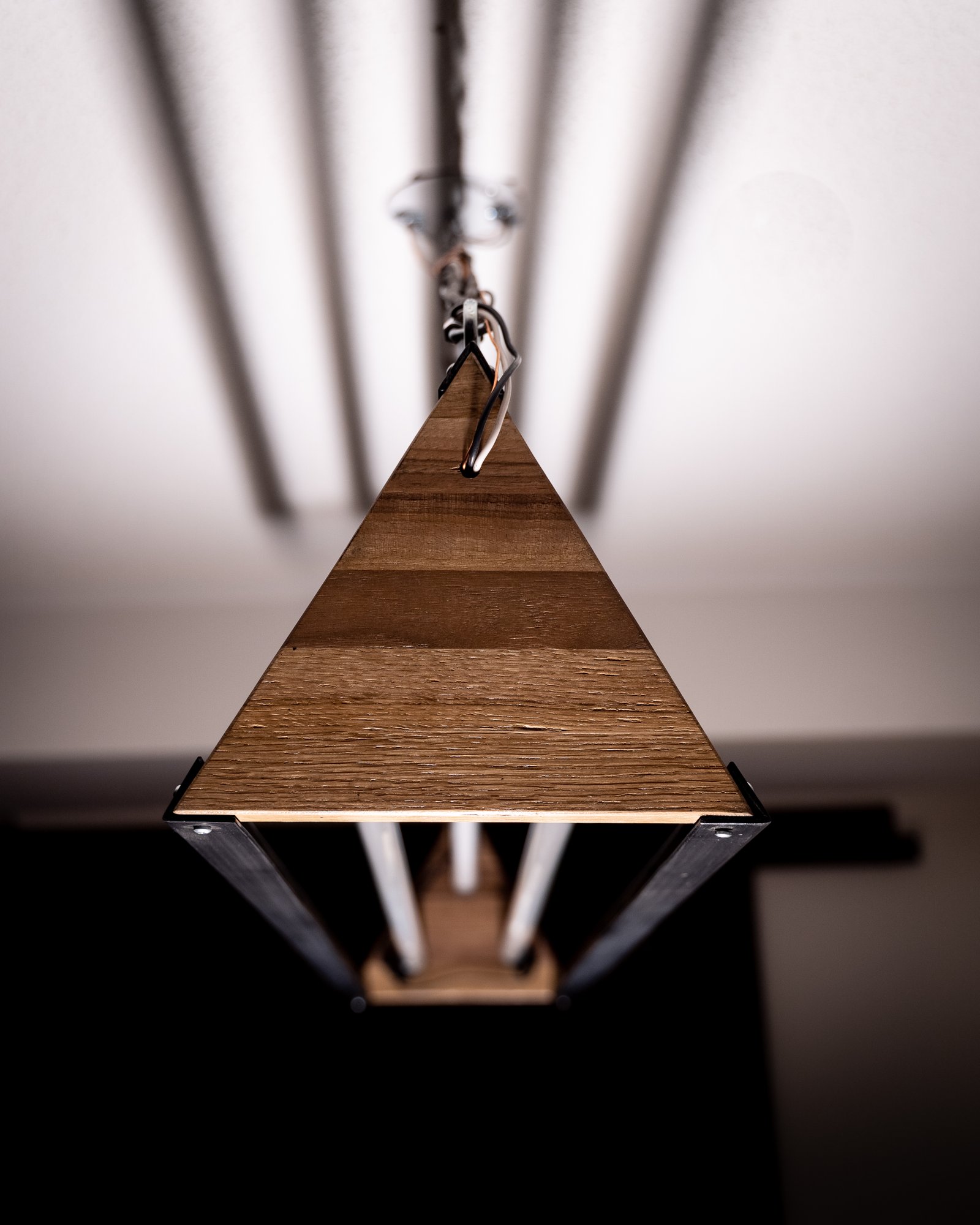
Okay, enough polished finish photos. Let’s talk about how I actually built the damn thing already.
I started with these offcuts from my last project. Some of you may have seen my Herringbone Coffee Table I posted a month or so ago
The offcuts are glued up strips of oak and walnut that I salvaged from another wood shop’s offcut pile. If you think about it, in my relentless pursuit of not paying for materials, I’m reusing offcuts, that were already reused offcuts. It’s like some sort of cheap guy dumpster diving inception loop.
In the end, I spent close to $200 on everything. The steel was ~$50, the lights and tombstones were ~$80, the chain and hardware was ~$50. There was probably some other misc bits I’m forgetting, but I’m confident the total cost was sub $200.

The offcuts we’re a little bigger than what I needed for this project. My first step was tracing some lines onto their surface that would then serve as guidelines for cutting these things down to size.
I wanted the end caps to be equilateral triangles with sides that were 10″ long. Highschool math taught me that the interior angle of any corner in an equilateral triangle is 60 degrees so that made figuring this all out pretty easy.
If I were going to do this project again I probably would’ve made these end caps smaller. If their sides had been 7-8″ long I think it would’ve given the whole fixture a slightly more compact and pleasing look. Oh well, next time!

I cut along my trace lines using a jigsaw. I’m pretty confident in my ability to cut a straight line with a jigsaw when I need to (and no one is watching, because I have serious jigsaw performance anxiety), but if you aren’t you could also do this cut on a table saw with a miter sled and get a perfectly straight line.
By the way, am I the only one that hates the ergonomics of jigsaws?! Look at me in the photo, I’m craning my neck over top of the saw just so I can see what I’m cutting. I’m saying I could make a better jigsaw, but someone needs to get working on this asap! 🙂

Using my random orbital sander and progressively higher grit sanding pads I wore away at the rough, glued spotted, surface of my triangles until they were smooth as silk.
Sanding things is generally the least enjoyable part of any project for me. It’s repetitive, boring, and doesn’t really require my full attention. To help pass the time I spend a lot of time listening to podcasts and audiobooks while I work. I’m up to a pretty good clip now, I can usually finish 2 books a month while I’m working. Not to mention countless podcasts.
During this project, I was listening to Spider Network by David Enrich. He tells the true story of a group of bankers who conspired together to rig the LIBOR benchmark (which is an interest rate benchmark used to set the interest rate on hundreds of financial products). These guys were betting billions of dollars on tiny, almost imperceptible, changes in interest rates in order to generate profits for their banks (and commissions for themselves in some cases). If you’re into reading business books by authors like Michael Lewis then I highly recommend this one. If not, you might find it a bit dry, but the author does a good job of staying out of the weeds of finance and sticking more to the characters involved.

Using a cordless drill and a 1/4″ drill bit, I drilled a hole in the end caps. This allowed me to feed the wires that supplied power to the lights “inside” the fixture.
Semi-related side note: I just bought a drill bit sharpener and love it. I have so many drill bits that are so dull they’re basically unusable. Using the sharpener I’ve brought a bunch of them back to life. Drill bits are surprisingly expensive, especially when you get into some of the bigger ones. The sharpener cost me a pretty penny, but it’s going to quickly pay for itself in rescued bits.

I quickly applied a couple of layers of clear coat onto the end caps. While it’s not really “necessary” on a build like this, I just really love the way wood looks with a good satin clear coat on it. It makes the grain pop and makes the colour of the wood seem sooo much more vibrant.
Plus it should make it easier to wipe the dust off in the future… Because I’m totally the type of person who cleans their light fixtures regularly…

I struggled for a while trying to figure out the best way to mount the “tombstones” to the end caps. They’re designed to be slotted into rails on purpose-built fixtures, not used in some random guys mad science experiment of a light fixture, so I knew I’d have to get a little creative.
I thought about screwing right through the front of them and into end caps. Unfortunately, I don’t have X-ray vision, and I didn’t want to risk my screw making contact with any metal inside the tombstone that carries current and potentially shorting it out.
I noticed some two part epoxy sitting on my shelf and thought “ya… maybe…?”. I was a little skeptical that it would be strong enough to do the job, but, what the hell I already had it. The epoxy was 2 part Gorilla Glue, which also had the benefit of drying clear. Which was a plus because it would help hide the inevitable excess glue squeezing out from behind the tombstone. Also, the packaging had a lot of hype about how strong it is, and I’m a sucker for marketing. Well played Gorilla Glue.

My fear of it not being strong enough quickly faded away. I’m happy to say that this stuff really sticks! I glued the test tombstone in place and after it dried I tried my hardest to get it to off. If I wanted to remove that tombstone, I probably would’ve had to completely destroy it, it was really on there.
Once I was satisfied that the glue was stronger than I was, I affixed the remaining 5 tombstones to the end caps.
Oh and please try not to criticize my sloppy glue job too much, I got better at applying the right amount of glue with the subsequent 5 tombstones.

Next up is wiring. I won’t get too specific here, because I’m no electrician (though I did consult a couple for this project) and don’t need that kind of liability in my life haha.
Basically though, you can daisy chain the tombstones together using 14/2 wire (this is the same wire you’d use for a light switch or outlet in a typical home). Power feeds from one tombstone to the next.
Depending on the type of tombstone you get (shunted vs non-shunted) the wiring procedure is a little different. Different bulbs have different wiring requirements too. Some bulbs need power at both ends, some are fed from just one end. If you want to do something similar I’d highly suggest you spend some time researching the parts you want to use and the proper wiring procedure. Don’t just blindly follow what I did here!

As I said, I’m no electrician, so I frequently tested my wiring. I wired up all 3 tombstones and then tried the bulb in each one. It works! And man is it bright!
Each tube light was good for about 2000 lumens, so I was seeing stars for a few minutes after this test.

My end caps were wired up and fully functional, so it was time to create the bracing that would link both of them together. As you saw in the finished photos I used 1 1/4″ angle irons for this bracing. The angle iron comes in 10′ foot lengths so my first job was cutting it down into more usable lengths.
My LED tube lights were 48″ long (including the thickness of the tombstones), and the end caps were 3/4″ thick so I had to cut three pieces of angle iron to 49.5″ long (48+.75+.75).
I marked some lines with a sharpie, attached a cut off wheel to my angle grinder and then made some sparks fly!

“But, aren’t angle irons 90-degree right angles?”. Why, yes they are. “And don’t you need the braces to have a 60-degree interior angle to match you end caps”. Nothing gets by you!
As it turns out, no one makes 60 degree angle irons. Which is a shame, but understandable, since I can’t think of any practical applications for them haha. So I had to modify my 90-degree angle irons a bit.
I switched the blade on my angle grinder to a grinding wheel and started removing material from the interior corner of the angle iron.

After a LOT of grinding, it started to look something like this. By removing material I was able to weaken that interior corner.
Then, using that bench vice and lot of elbow grease, I was able to fold the angle iron in on itself.

Not only did it take a long time to remove that much material from each of the braces with a grinding wheel, but, it also took a while to bend each piece.
My bench vice is only about 6″ wide. So I would start at one end of each piece, tighten the vice down until I achieved the angle I wanted, release it, slide it down 6″ and then rinse and repeat until I had my 60-degree angle iron.
I can’t complain though, it was a good forearm workout!
Periodically I would check my work using this handy digital angle gauge.

Now that I had the bending out of the way I was able to drill holes into the end of each piece of bracing. These holes would allow me to screw the braces to the end caps. I used a cordless drill and a 3/16″ drill bit to drill the holes.
The trick to drilling through metal is to use the slowest drill speed your drill has and apply as much downward pressure as you can muster. If you have access to some sort of lubricant it will help to keep your drill bit sharp and reduce heat. Or you can do what I do and just raw dog it, and then buy a drill bit sharpener later :).

I drilled some quick pilot holes into the end caps using a 1/16th drill bit. I did this because when I screw the braces to the end caps I don’t want the end caps to split on me.
Pilot holes help to reduce the amount of outward force a screw exerts as its screwed into something. It’s a good practice to be in whenever you’re screwing into any wood, especially if it’s thin or you’re close to the edge.
 I screwed some 3/4″ long #8 pan head screws through the braces and into the end caps which secured the whole thing together.
I screwed some 3/4″ long #8 pan head screws through the braces and into the end caps which secured the whole thing together.
Doing the first one was a pain in the ass haha, everything kept falling over on me. Once I got the first one screwed in place it made it a lot easier to do the last two. There’s a reason why I’m only showing you a picture of me screwing the last one in place. It’s important that I look like a slick professional in these guides, not the clumsy person I actually am haha.

I did a quick test fit of the bulb to make sure I had made everything the right length. One of the bulbs was a BIT tight, but with a little bit of gentle persuasion (read: hitting it lightly with the butt of the drill), I got it to fit.
In retrospect, I should’ve made the steel braces 1/8″ longer than I did, just to make it a bit easier to replace bulbs in the future. Good thing these bulbs are rated for 20,000 hours of use. I probably won’t ever have to replace them.

I built the majority of this project, and then let it sit for a few weeks. Partially it was because I was busy with other projects (and a vacation, can’t you see my tan!? ), but it was also partially because I never really figured out how I was going to mount it to the ceiling when I first started.
Eventually, after weeks of procrastination, I decided if I didn’t finish this project I’d be disappointing myself. And there’s no greater shame in life than disappointing yourself.
I got in my truck and drove to the hardware store so that I could browse for some mounting solutions. I settled on a big heavy chain because I thought it looked cool. I also considered using aircraft wire/braided steel cables, but I didn’t feel that it was in keeping with the rest of the project. When I got back to the shop I marked out two spots, 1.5″ from the end of each brace, where I was going to mount the anchors that would connect the chains.

Ugh, not the angle grinder again! Don’t I own any other tools?
Using my old standby and a grinding wheel I carved away at the steel until I had a small flat patch at the peak of the top brace.
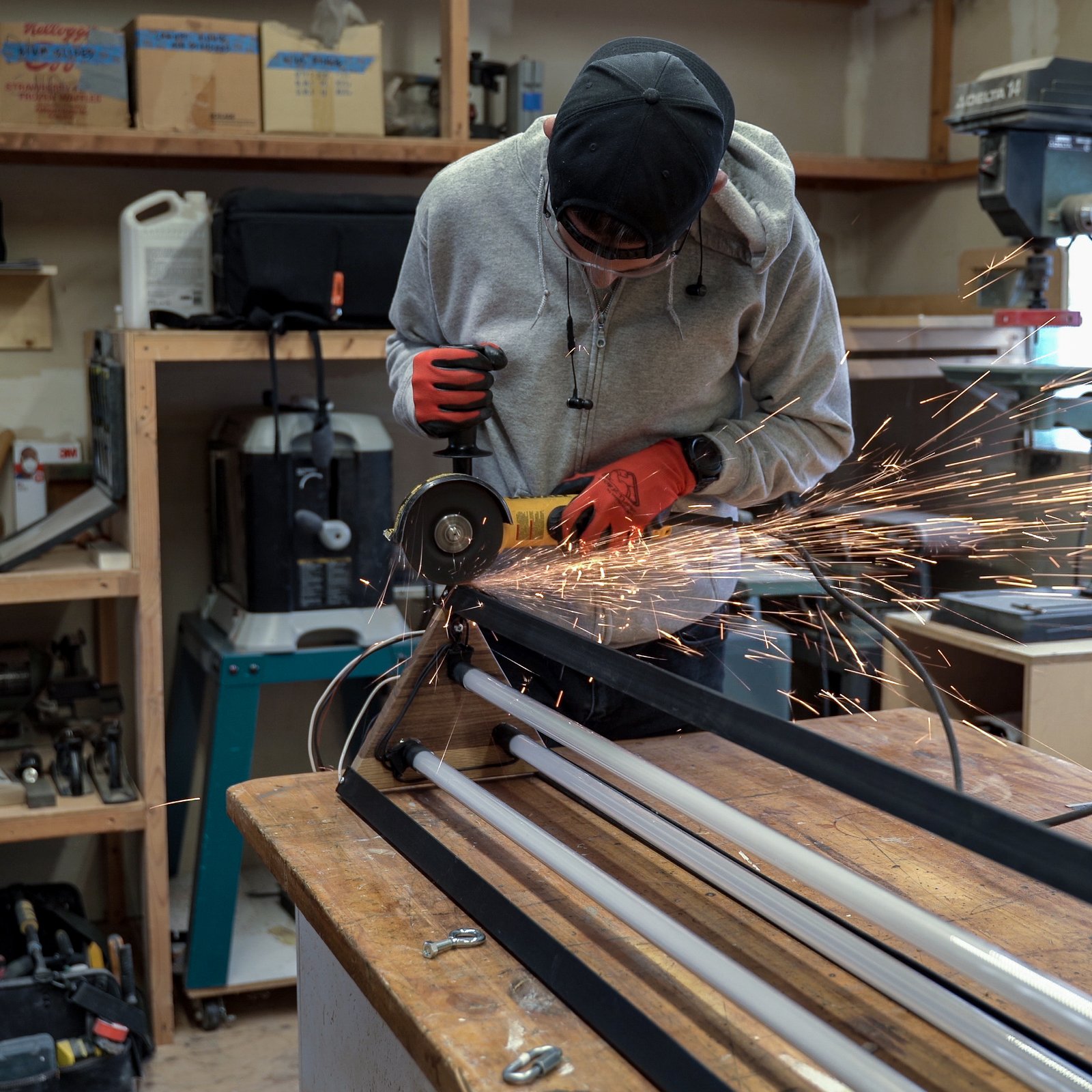
You might be asking why I flattened out the top of the brace. Well, once I had a flat spot I was able to use a 5/16″ drill bit to drill a hole down through the top of the brace. Obviously, if I had tried to do this without grinding the flat spot first, the drill bit would’ve just slid off of the brace.
And again, I stuck to my same slow and steady approach to drilling through metal. Lowest drill speed possible with as much downward pressure as possible. Before I knew it, I had two 5/16″ holes that I could attach my anchors to.
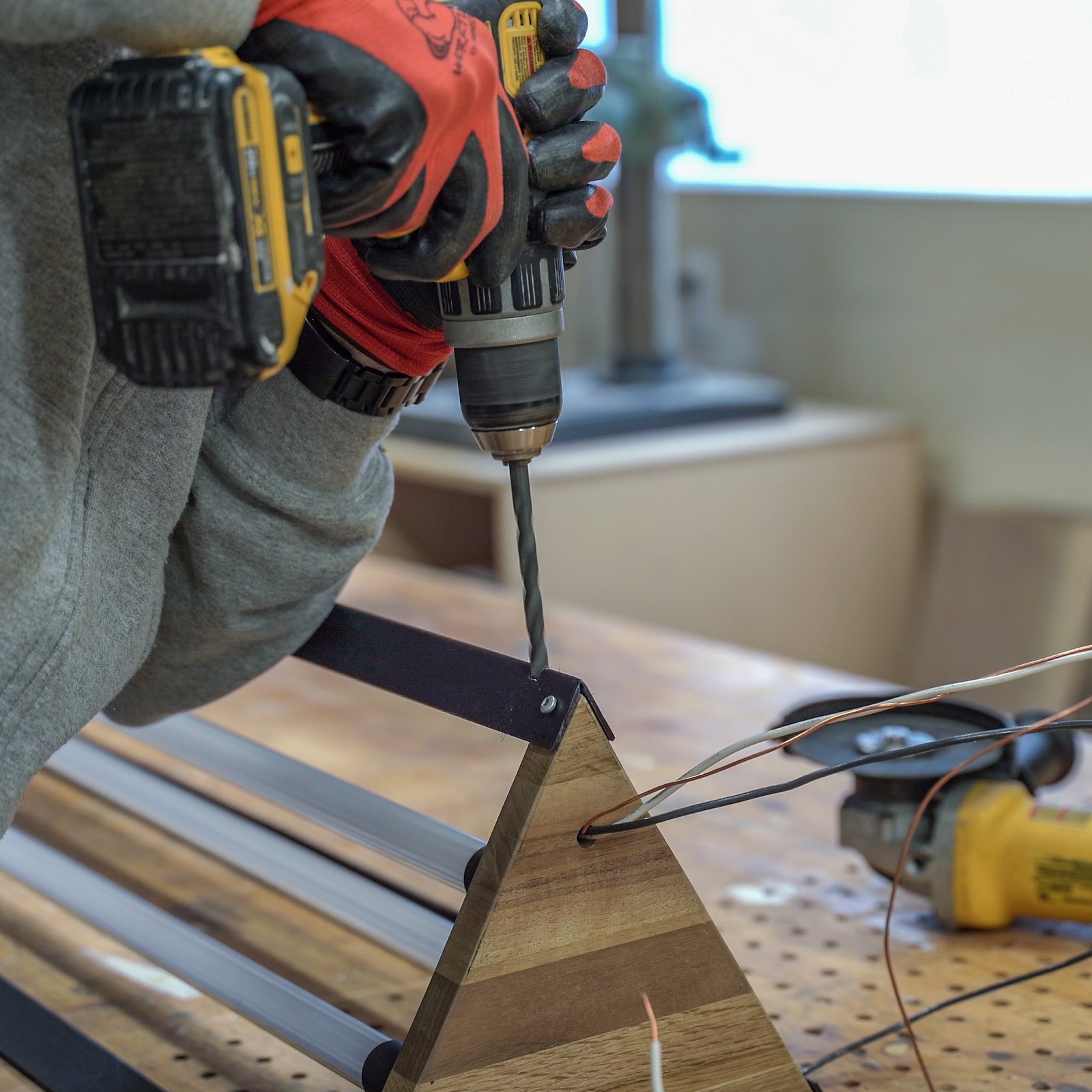
I threaded these 5/16 eyebolts through the holes and attached a nut on the inside of the brace. To ensure that the nut never came loose I applied a generous amount of thread locker (Loctite) to the threads of the nut.
For those of you that aren’t familiar with thread locker its a really useful product. It comes in little squeeze bottles as a liquid that you apply to the threads of a bolt or nut, screw them together and then it hardens and locks them in place. You can get it in various strength depending on what your application is.
Probably overkill here, it’s not like this light fixture is going to be subject to any movement or vibrations, but it’s just good peace of mind.

We know how the chains are going to mount to the light fixture, but how are they going to mount to the ceiling? Good question.
Most ceiling hung light fixtures mount to what are called octagon boxes (at least here in Canada they do) which is a standard household electrical junction box. Look around you, are there any lights mounted to the ceiling that aren’t pot lights? If so, there’s probably an octagon box underneath it/them(well, technically above them, but you know what I meant). When people move light fixtures or remove them they’re often left with exposed octagon boxes in their ceilings or walls which looks quite ugly, so hardware stores sell these blank white octagon box covers for a couple of bucks. It’s just a simple metal plate made to cover a vacant box but they’re made of metal and decently strong so I decided to use one as my starting point.
I drilled one hole in the center and 2 larger holes on the flanks.

In the center hole, I mounted another eye bolt (with thread locker again). I’ll connect the chains to the eye bolt and that will then carry the load of the light fixture.
In the other two holes I mounted two clamping knockout conduit connectors for the wires. The clamping knockouts are again pretty standard in residential wiring. You use them when you have a wire passing through sheet metal. When they’re clamped down on the wires it prevents wires from moving and rubbing against any sharp edges and exposing their conductive cores. I’ll run the wires through the knockouts and then clamp them down in order to prevent my wires from fraying.

When I bought the chain at the hardware store it came in a single 5′ length. I wanted two separate chains that were equal lengths so I counted out two 20 ring long chains and cut them with the *sigh* angle grinder….
Now look, I promise this is the last angle grinder shot. I’m sick of them too. But how else could I tell this story? I didn’t knaw through the chain with my teeth. I really wish I had a big set of bolt cutter I could’ve used instead but I don’t. I’m sorry.

Using 4 chain links I linked my two lengths of the chain to either end of the fixture and then back to the center eyebolt in the cover plate. These chain links were pretty cool, they have a section in the middle the unscrews and allows you to loop them into chain links, then you screw the metal section shut and wallah! You have a complete chain.
With my chains sorted I then weaved my wires through the rings of the chain to keep it all organized and neat.
Ideally, I would’ve come up with a more modular design because mounting this was kind of a pain in the ass, but I’ll talk more about that later.

You know you can sand metal, right? Not only does it help smooth out its surface, just like sanding wood, but you can use it to round off any sharp edges left over from cutting. It also helps paint adhere to the metal better. It’s just a good practice to be in if you’re working with metal in any of your projects.
I gave all of the metal braces a quick sand with some 80 grit sanding pads on my random orbital sander. After the sanding, I wiped them all down with a rag lightly doused in varsol. The varsol helps to remove any oil and metal dust left over from the sanding.

My original plan was just to paint the steel braces and call it a life. I looked at the end caps and felt they were too busy looking. With all the wires, the tombstones, and the bulbs there were just too many different shades of white going on. I decided to black out as much of this project as I could to make it all look cleaner.
I spent a few minutes masking everything off with some blue painters tape, donned my respirator and then sprayed everything down with some flat black spray paint. Are the kids still calling this “murdering it out”? Well murder it out I did.
In general, when I’m designing projects I like to minimize the number of different design elements. I find painting things all the same colour is a really easy way to make different materials appears as if they are all the same.
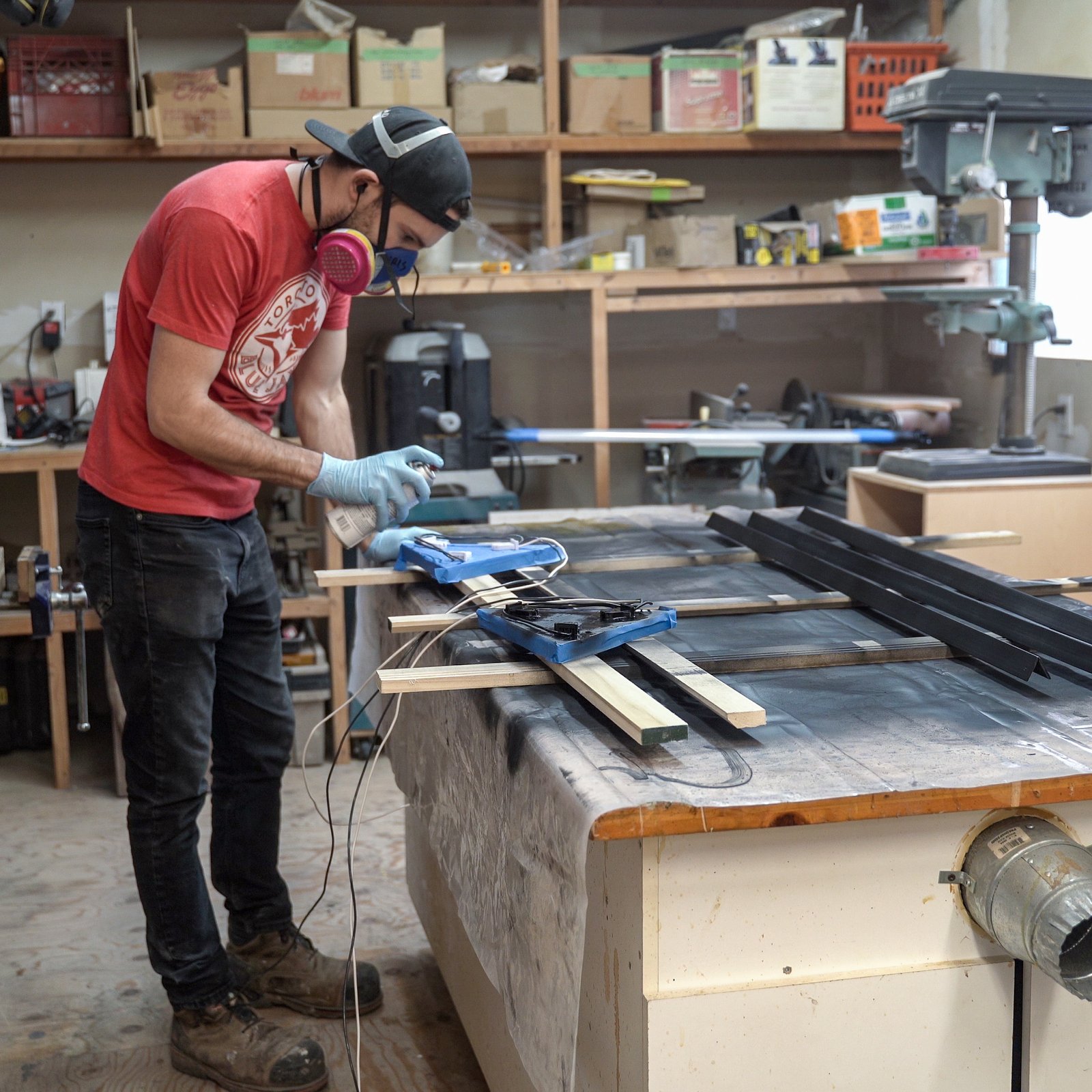
Hell, I even did the ends of the bulbs too. I figured if I was going to do, I might as well really go for it!
I let all of the paint dry overnight and then re-assembled everything the next day and got it ready to be installed.

Here’s my old light fixture. Yuck.
I’ve hated that thing since the day I moved into my place. Not only is it ugly (my subjective opinion) but it uses these super hard to find bulbs that kick off a ton of heat, so they can’t be very energy efficient.
I switched off the breaker that supplied electricity to the fixture and commenced taking it down with a giant smile on my face. You know, that smile you get when someone gets exactly whats coming to them? Ya, that kind of smile haha.

That smile quickly faded when it came time to install my new light fixture though. It isn’t as heavy as it looks, but it’s also not exactly light. Remember before how I was saying I wish I designed it in a more modular way? Ya, that would’ve been nice.
I had to wire up the fixture and then screw the cover plate onto the octagon box in the ceiling all while supporting the weight of the entire fixture within 12″ of the ceiling.
Eventually, I came up with this super sophisticated setup. I balanced the fixture on two stools and that held it high enough in the air that I had enough slack in the chains and wires to hook everything up.

Here you can see how everything is mounted. The cover plate is screwed to the octagon box (which is screwed to the ceiling joists), the eye bolt is bolted to the cover plate and then the two chains supporting the fixture are connected to the eye bolt using two chain links. Pretty simple, but it took me a while to piece this all together conceptually haha.
Unfortunately, the original builders of my place didn’t do a very good of cutting the ceiling drywall around the octagon box. Even with the cover plate installed there’s still a small gap on one side of it. Oh well, maybe one day I’ll fix it with a bit of plaster, but it’s not that noticeable for now.

Here’s a close up of the chain links I mentioned earlier. I was at the hardware store and really liked the idea of using chain, but it dawned on me that I had no idea how to connect chains to anything. I found the eye bolts and was thinking about cutting the chain, bending it, looping it on, and then re-welding it together. Then I saw these chain links realized that of course someone had already thought of a much better solution than all that work haha.
That hex nut looking thing in the middle is what unscrews and allows you to link the link into the chain.

Have you ever tried to take photos of lights that are turned on before? It isn’t easy haha. The lights are so bright it overpowers everything else and forces the camera to underexpose the rest of the room. Not ideal for me trying to show my work. So I kind of “faked” the lights being on by shining these two LED lights right into the fixture.
Not bad right? Would you have known if I didn’t tell you?
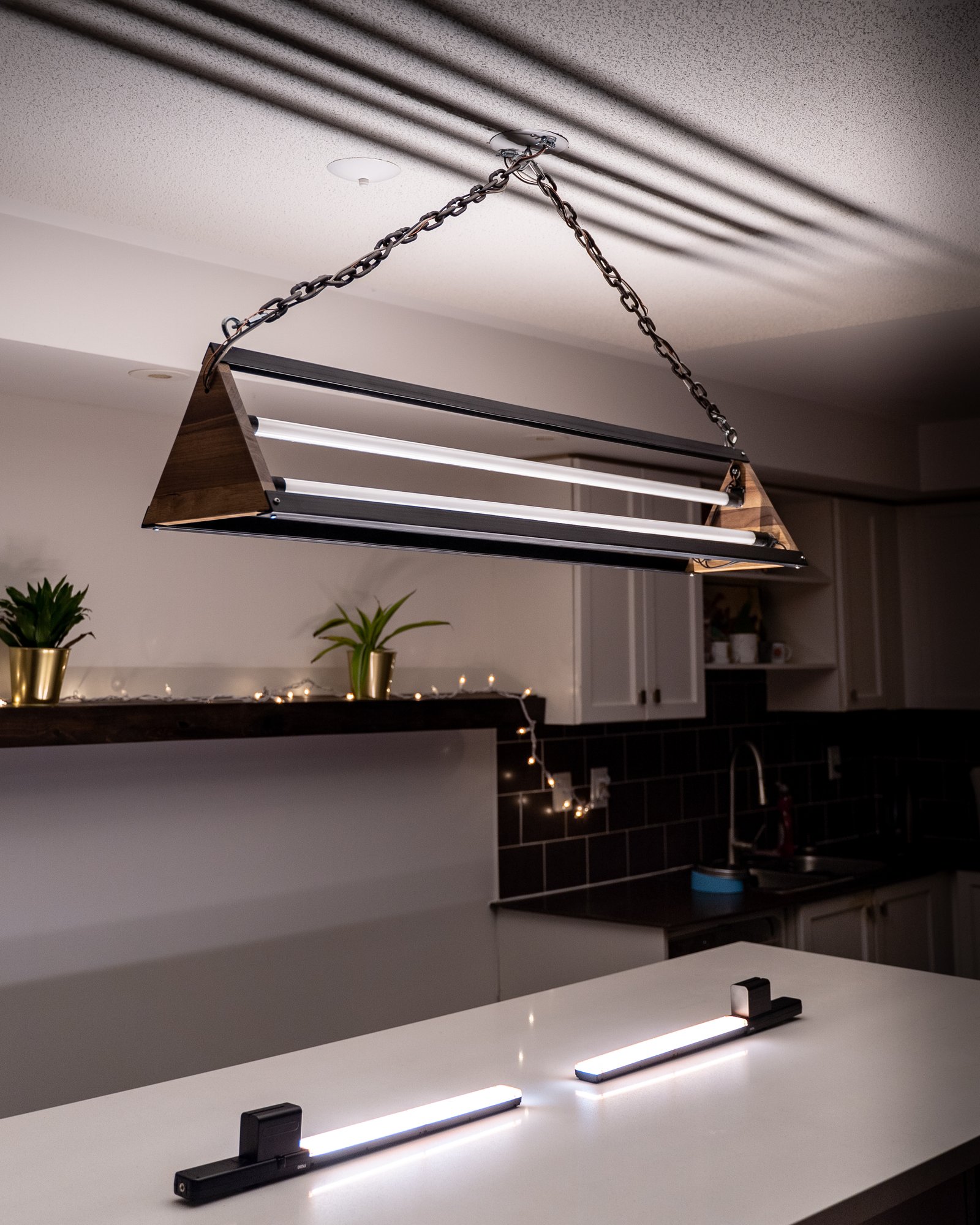
Originally my plan was to make the whole fixture out of steel, but I thought that would be bit too cold looking. Adding the wooden end caps was my way of bringing a little warmth to the whole industrial look of the project.
The fact that its oak and walnut glued together is just a bonus, if I didn’t already have the offcuts I used for the end caps I probably would’ve made them out of a single piece of wood. None the less I’m happy I didn’t.

I know I said I wouldn’t go into much wiring, but as you can see from this photo, it isn’t rocket science. Obviously do your research before ever working with electricity and be as safe as you can, but it’s not black magic that’s beyond the understanding of the average person.
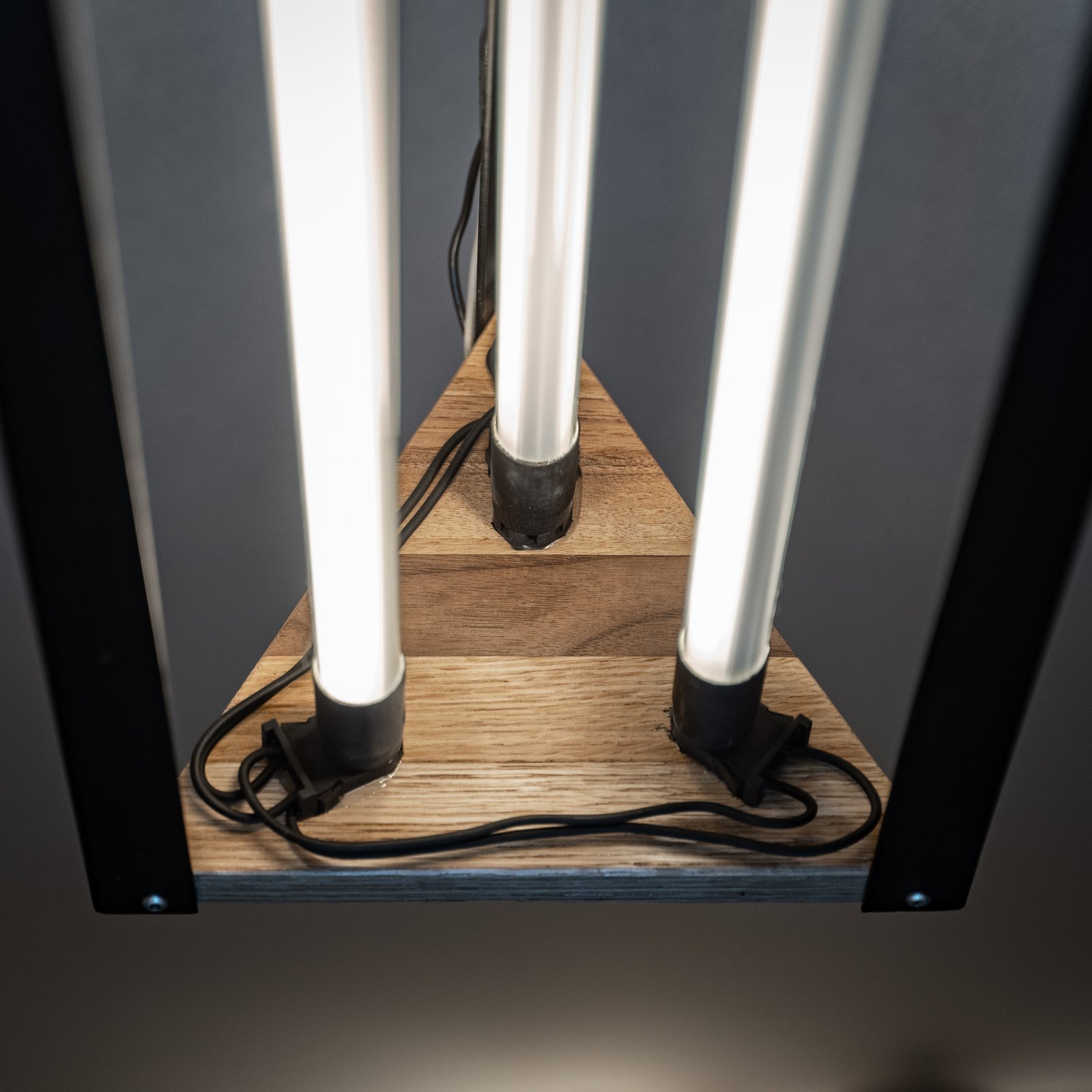
Thanks for checking out my build! I applaud you if you made it this far! If you have any questions or comments let me know below and I’ll do my best to answer all of them! (Unless they’re rude, in which case I’ll probably just ignore them haha)

Again if you liked this build, check me out on Instagram (link in the first post), because I post there much more frequently than I do on this blog!